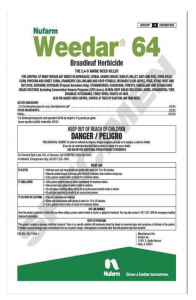Aquatic Herbicides: Essential Information for New Applicators
- Jump To:
- Aquatic Herbicides are Safe
- There is No General Purpose Aquatic Herbicide
- Aquatic Herbicide Applications Are Not Cheap
- Herbicides are Usually Fast Acting, but Short Lived
- Fish Kills are Possible
- Applying Herbicides to Water Takes Extra Care
- Read the Product Label
- Consider Hiring It Done
- Other Ways to Manage Pond Plants
This leaflet aims to highlight important things to know when using aquatic herbicides. This is a quick reference to the most important issues when using aquatic herbicides. The recommended fact sheets listed later contain additional useful information.
Aquatic Herbicides are Safe
The Extension Service will only recommend herbicides that are labeled and have been tested and approved for safety and effectiveness. With a little understanding and care, using aquatic herbicides is safe. NREM – 101
There is No General Purpose Aquatic Herbicide
First, correctly identify the problem plant to match it to an effective herbicide. Your Extension educator can help. Do not waste time, effort and money on the wrong treatment. Other factors in choosing a herbicide include cost, ease of application and withdrawal time: the number of days before a treated pond can be used for fishing, irrigation, livestock watering and other uses.
Aquatic Herbicide Applications Are Not Cheap
The cost of a herbicide can be high somewhere between $100 and $600 to treat an acre of plants. The cheapest is not always the best value. You must choose among herbicides based on effectiveness and cost.
Herbicides are Usually Fast Acting, but Short Lived
Problem plants come back unless underlying problems are corrected. Your county educator can help identify those underlying problems and some possible solutions.
Fish Kills are Possible
There is a chance of a fish kill if too much plant material dies and decomposes at one time. Time of year matters:
- The heat of summer and early fall are riskier times to apply herbicides: when too much plant material dies at once, it may rapidly decompose, using up all the oxygen in the water. It is best to treat in sections or wait until spring.
- Treating only one-fourth of the problem area at a time is often advised. Note: in some cases this is not possible the herbicide may be slow acting and intended for whole pond application only.
- Late fall and winter are not the time to do herbicide applications. Herbicide effectiveness is low
- Spring is normally the best time for herbicide applications.
Applying Herbicides to Water Takes Extra Care
You may be experienced at applying herbicides to pastures, crops or yards, but water is different. When mistakes are made with aquatic herbicides several things could go wrong:
- Fish kills.
- Harm to livestock and pets drinking from ponds. They often should be kept out for a recommended withdrawal time.
- People who fish or swim should also be kept out for a recommended withdrawal time.
Also note that pond applications are often more difficult than other herbicide applications:
- Calculating rates and amounts can be a more work since the volume of water being treated may need to be calculated
- If you must apply herbicide from a boat, the work can involve more effort and care to get good, even coverage
Certain counties may have special use restrictions for herbicides. Contact the Oklahoma Department of Agriculture for information.
Read the Product Label
Before purchasing a herbicide, first read and understand the product label. The label is the law!
The label explains in detail
- Which type of site may be legally treated with the herbicide (ex: ponds and lakes, flowing waters, canals, reservoirs)
- How to use the herbicide
- Which rates to use for specific plants and environmental situations.
- Precautions that should be taken, such as safety gear for handling, and requirements for worker protection
- First aid in case of accident
Follow all label instructions. Ask for help if something is unclear.
Double check your calculations.
More information on specific herbicides and links to labels can be found at AquaPlant and in these two fact sheets available through your Extension office or online.
Understanding and following label directions protects your health and pocketbook against legal liability. Seek help from your county Extension agriculture educator as needed to understand label instructions and rate calculations.
- Do not apply at more or less than the label rate.
- Do not apply to flowing water situations without seeking approval from state and other regulatory agencies.
If spraying, adjust nozzle for coarse droplet size and spray when it is not windy to avoid drift.
- Fine droplets can be carried downwind.
- The vapor from 2,4-D ester herbicide is a threat miles downwind – Read the label.
Store unused herbicide in cool and dry conditions or it will be damaged and ineffective when you try using it later.
Consider Hiring It Done
A list of licensed applicators is available from the Oklahoma Department of Agriculture. An aquatic applicator may or may not be available in your area.
Other Ways to Manage Pond Plants
Explore additional methods of discouraging excess plant growth:
- Aquatic dyes work to starve young submerged plants for light. They are preventative only. Dyes must be replenished several times each year and whenever there is a large pond overflow.
- Grass carp are effective against only certain soft plants and have several other drawbacks. CR-9202.
- Deepen shallow pond areas most often these are pond edges that have shallowed out over time.
- Reduce nutrient runoff into ponds especially phosphorus from fertilized lawns and fields and from animal manure.
- Is there a thick, black layer of organic matter on the pond bottom? It may be releasing phosphorus, fueling the excess growth of plants.

